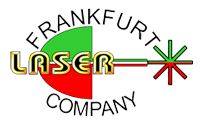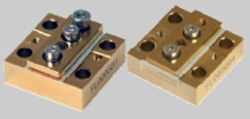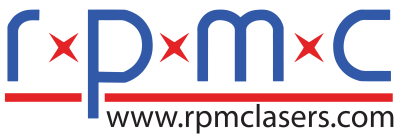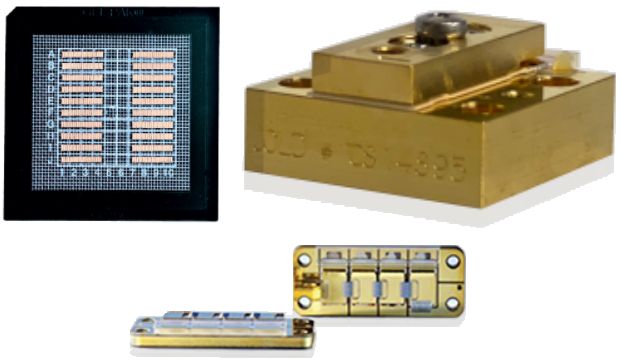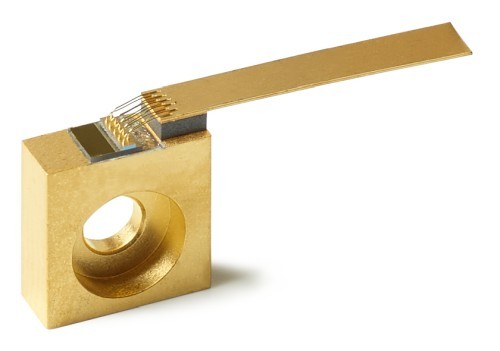diode bars (original) (raw)
Author: the photonics expert (RP)
Definition: a type of semiconductor laser containing a one-dimensional array of broad-area emitters
Alternative term: diode arrays
More general term: diode lasers
Categories:  optoelectronics,
optoelectronics,  laser devices and laser physics
laser devices and laser physics
DOI: 10.61835/ufs [Cite the article](encyclopedia%5Fcite.html?article=diode bars&doi=10.61835/ufs): BibTex plain textHTML Link to this page LinkedIn
A diode bar is a high-power semiconductor lasers (laser diodes), containing a one-dimensional array of broad-area emitters, or alternatively of subarrays containing 10–20 narrow stripes (see Figure 1). Such stripes typically contain between 20 and 50 emitters, each being e.g. 100 μm wide. A typical commercial device has a laser resonator length of the order of 1 mm, is 10 mm wide and generates tens of watts of output power or even up to ≈200 W; some prototypes even reach several hundreds of watts (possibly with a reduced lifetime). Within the last 20 years, the price per watt has come down by nearly two orders of magnitude, while at the same time the brightness (for a given power level) has been substantially improved.
The reason for the use of diode arrays instead of simply making very broad single emitters is that the latter would suffer from amplified spontaneous emission or parasitic lasing in the transverse direction, or from the formation of filaments. Diode arrays can be operated with a more stable mode profile, consisting of one so-called beamlet from each emitter. There are several techniques which exploit some degree of coherent coupling of neighbouring emitters, leading to better beam quality. Such techniques include those directly applied in the fabrication of the diode bars and others involving external cavities. Most diode bars, however, are used without such a technique.

Figure 1: Schematic view of the semiconductor chip of a diode laser bar with a fill factor of 50%.
Important design parameters of diode bars are the number of emitters, their width and spacing. With respect to beam quality and brightness, it is ideal to get the output power from a small number of closely spaced emitters. However, the optical intensity at the output facet is limited by the risk of catastrophic optical damage of the mirror coatings, and the output power is also limited by the active volume. In addition, closely spaced emitters may be too difficult to cool, at least in continuous-wave operation; such diode bars are sometimes used only in quasi-continuous-wave operation with not too long pump pulses.
Note that the array geometry makes diode bars very suitable for methods of coherent or spectral beam combining, which make it possible to obtain a much higher beam quality.
Emission Wavelengths and Bandwidth
Most diode bars operate in the wavelength region from 780 to 860 nm or between 940 nm and 980 nm. The wavelengths of 808 nm (for pumping neodymium lasers) and 940 nm (for pumping Yb:YAG) are most prominent. Another important wavelength is around 975–980 nm for pumping erbium-doped or ytterbium-doped high-power fiber lasers and amplifiers.
The emission bandwidth of a diode bar typically amounts to several nanometers, which can be more than desirable for pumping a solid-state laser. In addition, there is typically a tolerance of several nanometers for the center wavelength. A strongly reduced wavelength tolerance and emission bandwidth may be achieved with optical feedback, e.g. from a volume Bragg grating. This can facilitate the pumping of a solid-state bulk laser, for example, particularly when using a laser crystal with a small absorption bandwidth. The bandwidth and exact center wavelength can also be important when using spectral beam combining.
Spatial Beam Properties; Beam Collimation
A non-ideal property of diode bars is the spatial pattern of its emission. In the “fast axis” direction (corresponding to the vertical direction in Figure 1), the emission comes from a very narrow region, so that the beam quality is not far from diffraction-limited (_M_2 factor not far above 1) despite the large beam divergence angle of typically 30–40° FWHM (full width at half-maximum). On the other hand, the “slow axis” direction has a very wide emitting region, so that despite the much smaller divergence angle (of the order of 6–10°) the beam quality is very poor, with the _M_2 factor > 1000. Significant efforts are therefore often required for conditioning the output of a diode bar (or of multiple diode bars in the form of a diode stack).

Figure 2: Photograph of actively cooled diode bars from JENOPTIK Laser Diode GmbH.
The large numerical aperture (NA) of typically ≈ 0.6 for the fast axis requires high-NA aspheric lenses for collimating the beams (beamlets) while preserving the beam quality.Fast axis collimators, containing a kind of cylindrical lens (often with a somewhat non-cylindrical surface for reduced spherical aberrations), are commonly used for that purpose. There are also slow axis collimators for beam collimation in the other direction, where the demands are lower concerning the NA of typically ≈ 0.1, but nevertheless not uncritical for diode bars with high fill factor (see below). When beams with approximately circular beam waist and reasonable beam quality are required, a special beam shaper for symmetrization of the beam quality can be applied.
For more details on beam collimation, see the articles on laser diode collimators and beam collimators.
A potentially disturbing property of diode bars is the “smile” – a slight bend of the horizontal line connecting the emitters. Smile errors can have detrimental effects on the ability to focus beams from diode bars. There are some advanced beam conditioning schemes where the smile of individual diode bars is compensated.
Fiber Coupling
Many diode bars are sold in fiber-coupled form because this often makes it much easier to utilize their output and also makes it possible to mount the diode bars with their cooling arrangement in some distance from the place where the light is used (e.g. a diode-pumped laser head). Usually, the light is coupled into a single multimode fiber, using either a simple fast-axis collimator and no beam conditioning in the slow-axis direction, or a more complex beam shaper to preserve the brightness better. It is also possible to launch the beamlets from the emitters into a fiber bundle (with one fiber per emitter).
See the article on fiber-coupled diode lasers for more details.
Cooling
The semiconductor chip of a diode bar is soldered to a thin submount, which also gives one of the electrical connections. An insulated wire bond plate provides the second connection. The submount is then mounted on some heat sink, which is often water-cooled (with a macrochannel or microchannel cooler), allowing for a high fill factor (ratio of emitter width to total width of emitting region) of e.g. 80% and thus for a high brightness. Conduction-cooled bars (often used with a thermoelectric cooler) have a lower fill factor of e.g. 30% because the heat can be extracted less efficiently. In both cases, diode bars are often produced in sealed packages.
Power Efficiency
Electrically, the different emitters are all connected in parallel. This means that the overall drive current (to be delivered by the laser diode driver) is substantial, of the order of tens or even hundreds of amperes. One obtains of the order of 1 W of optical output power per 1 A of current; combined with the typical voltage drop of the order of 2 V, this results in a power efficiency (→ wall-plug efficiency) of the order of 50%, or somewhat higher for modern devices.
Further developments are under way to reach 80% efficiency. Crucial technological issues are to reduce the operating voltage by optimizing electrical contacts and layer structures, to further reduce the thermal impedance, and to improve methods for facet passivation, effectively allowing higher optical intensities without the risk of catastrophic damage. Improved power efficiency reduces the total electrical power demands and also the demands on the cooling system, and further usually allows for higher brightness. Often it comes with the additional effect of reducing the price per watt of output power, which is already well below 30 US dollars.
Lifetime
Under ideal conditions, diode bars can have lifetimes of many thousands of hours. However, devices often fail long before the specified lifetime is reached. This is not necessarily a consequence of faults in the production or the design, but can be caused by a variety of factors outside the control of the manufacturer, such as short voltage spikes caused by a defective or ill-designed laser diode driver (often during switching the device on or off), or by too high an operation temperature, which itself can be caused by too high a drive current or insufficient cooling. Water cooling is usually fairly effective, but its effectiveness can be strongly compromised by corrosion, which can occur e.g. when the specifications for the chemical condition of the cooling water (particularly its ion content) are not met. On the other hand, too strong cooling can cause problems via condensation, when the dew point is reached. Besides, deviations from the intended operation temperature can lead to substantial deviations of emission wavelength, typically with a temperature coefficient around 0.3 nm/K. Obviously, the whole diode laser system has to be properly designed to exploit the full lifetime potential of the bars.
Applications
High-power diode bars are directly used (as direct diode lasers) in laser material processing (e.g. laser welding and certain surface treatments) and as medical lasers (e.g. for photodynamic therapy, tattoo removal, laser surgery). Diode bars are also developed further for military use as battlefield laser weapons. For very high powers (above roughly 100 W), one uses diode stacks, which are essential several diode bars stacked in the vertical direction.
Another common application is pumping of high-power solid-state lasers – both bulk and fiber lasers.
In the future, diode bars may also increasingly be applied in large-volume consumer products such as cars.
More to Learn
Encyclopedia articles:
Blog articles:
- The Photonics Spotlight 2010-04-16: “Why Large Mode Area Waveguides Do Not Work for Laser Diodes”
Bibliography
| [1] | J. G. Endriz et al., “High power diode laser arrays”, IEEE J. Quantum Electron. 28 (4), 952 (1992); https://doi.org/10.1109/3.135214 |
|---|---|
| [2] | X. Gao et al., “Effective suppression of beam divergence for a high-power laser diode bar by an external-cavity technique”, Opt. Lett. 29 (4), 361 (2004); https://doi.org/10.1364/OL.29.000361 |
| [3] | R. K. Huang et al., “High-brightness slab-coupled optical waveguide laser arrays”, IEEE Photon. Technol. Lett. 17 (5), 959 (2005); https://doi.org/10.1109/LPT.2005.845692 |
| [4] | H. Li et al., “Near 1 kW of continuous-wave power from a single high-efficiency diode-laser bar”, IEEE Photon. Technol. Lett. 19 (13), 960 (2007); https://doi.org/10.1109/LPT.2007.898820 |
| [5] | G. L. Bourdet et al., “High-power, low-divergence, linear array of quasi-diffraction-limited beams supplied by tapered diodes”, Appl. Opt. 46 (25), 6297 (2007); https://doi.org/10.1364/AO.46.006297 |
| [6] | N. Stelmakh et al., “External-to-cavity lateral-mode harnessing devices for high-brightness broad-area laser diodes: concept, realizations, and perspectives”, Proc. SPIE 7230, 72301B (2009); https://doi.org/10.1117/12.808681 |
| [7] | R. Diehl (ed.), High-Power Diode Lasers: Fundamentals, Technology, Applications, Springer, Berlin (2000) |
| [8] | D. Botez and D. R. Scifres (eds.), Diode Laser Arrays, Cambridge University Press, Cambridge (1994) |
(Suggest additional literature!)

Suppliers
The RP Photonics Buyer's Guide contains 30 suppliers for diode bars. Among them:
Monocrom
Monochrom offers laser diode packages for a single laser bar with conduction or water macro-channels cooling and an unprecedent low smile.
Our single bar diode laser mounts are clamped with Monocrom's solder-free laser bar Clamping™ technique that improves overall performance and prolongs laser diode life-time.
There is an option to add a variety of optics assemblies to collimate both optical axes.
QPC Lasers
QPC Lasers full vertical integration from epitaxy through packaging allows us to offer standard and custom arrays as unmounted bars, mounted on heat sinks, or integrated into lensed stacks.
Frankfurt Laser Company
Frankfurt Laser Company offers a broad choice of laser diode bars (diode arrays), spanning wavelengths from 660 nm to 1850 nm, output powers of up to 80 W and different packages.
RPMC Lasers
Serving North America, RPMC Lasers offers a large selection of multimode laser diode bars (arrays), ranging from 760 nm IR through 1470 nm SWIR, with output powers ranging from 6 W up to 400 W CW output & up to 500 W QCW output, available in free-space and fiber-coupled options. These diode bars are available unmounted or packaged on a heatsink. Standard and custom options available. Let RPMC help you find the right laser today!
Focuslight Technologies
Focuslight Technologies offers laser diode bars:
- the conduction-cooled HCS02 with emission wavelengths of 808 nm, 940 nm, 976 nm and 1060 nm, and up to 80 W output power
- the water-cooled MCC09 with up to 500 W quasi-CW or 120 W CW at 808 nm or 940 nm
Sheaumann Laser
Sheaumann Laser offers diode bars with emission wavelengths between 780 nm and 1710 nm, suitable e.g. for pumping solid-state lasers and fiber lasers. Different packaging options are available: B-mount, C-mount, CL-mount, CS mount and fiber-coupled in a high heat load (HHL) package.
Questions and Comments from Users
Here you can submit questions and comments. As far as they get accepted by the author, they will appear above this paragraph together with the author’s answer. The author will decide on acceptance based on certain criteria. Essentially, the issue must be of sufficiently broad interest.
Please do not enter personal data here. (See also our privacy declaration.) If you wish to receive personal feedback or consultancy from the author, please contact him, e.g. via e-mail.
By submitting the information, you give your consent to the potential publication of your inputs on our website according to our rules. (If you later retract your consent, we will delete those inputs.) As your inputs are first reviewed by the author, they may be published with some delay.



